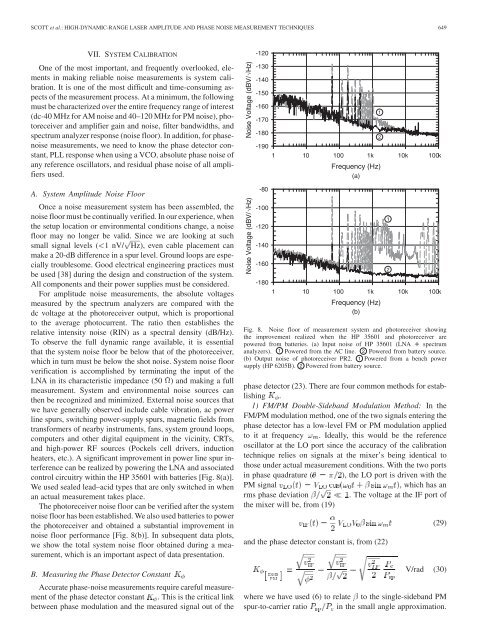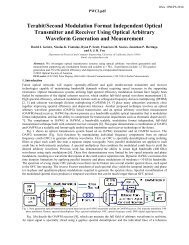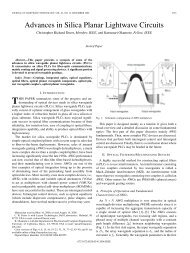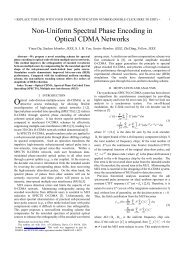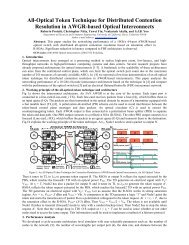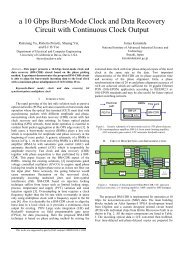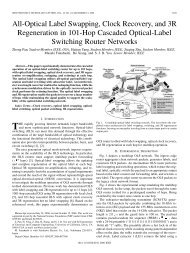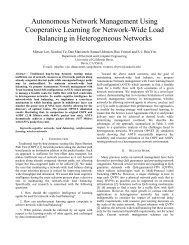High-Dynamic-Range Laser Amplitude and Phase Noise - Next ...
High-Dynamic-Range Laser Amplitude and Phase Noise - Next ...
High-Dynamic-Range Laser Amplitude and Phase Noise - Next ...
You also want an ePaper? Increase the reach of your titles
YUMPU automatically turns print PDFs into web optimized ePapers that Google loves.
SCOTT et al.: HIGH-DYNAMIC-RANGE LASER AMPLITUDE AND PHASE NOISE MEASUREMENT TECHNIQUES 649<br />
VII. SYSTEM CALIBRATION<br />
One of the most important, <strong>and</strong> frequently overlooked, elements<br />
in making reliable noise measurements is system calibration.<br />
It is one of the most difficult <strong>and</strong> time-consuming aspects<br />
of the measurement process. At a minimum, the following<br />
must be characterized over the entire frequency range of interest<br />
(dc-40 MHz for AM noise <strong>and</strong> 40–120 MHz for PM noise), photoreceiver<br />
<strong>and</strong> amplifier gain <strong>and</strong> noise, filter b<strong>and</strong>widths, <strong>and</strong><br />
spectrum analyzer response (noise floor). In addition, for phasenoise<br />
measurements, we need to know the phase detector constant,<br />
PLL response when using a VCO, absolute phase noise of<br />
any reference oscillators, <strong>and</strong> residual phase noise of all amplifiers<br />
used.<br />
A. System <strong>Amplitude</strong> <strong>Noise</strong> Floor<br />
Once a noise measurement system has been assembled, the<br />
noise floor must be continually verified. In our experience, when<br />
the setup location or environmental conditions change, a noise<br />
floor may no longer be valid. Since we are looking at such<br />
small signal levels ( 1nV/ Hz), even cable placement can<br />
make a 20-dB difference in a spur level. Ground loops are especially<br />
troublesome. Good electrical engineering practices must<br />
be used [38] during the design <strong>and</strong> construction of the system.<br />
All components <strong>and</strong> their power supplies must be considered.<br />
For amplitude noise measurements, the absolute voltages<br />
measured by the spectrum analyzers are compared with the<br />
dc voltage at the photoreceiver output, which is proportional<br />
to the average photocurrent. The ratio then establishes the<br />
relative intensity noise (RIN) as a spectral density (dB/Hz).<br />
To observe the full dynamic range available, it is essential<br />
that the system noise floor be below that of the photoreceiver,<br />
which in turn must be below the shot noise. System noise floor<br />
verification is accomplished by terminating the input of the<br />
LNA in its characteristic impedance (50 ) <strong>and</strong> making a full<br />
measurement. System <strong>and</strong> environmental noise sources can<br />
then be recognized <strong>and</strong> minimized. External noise sources that<br />
we have generally observed include cable vibration, ac power<br />
line spurs, switching power-supply spurs, magnetic fields from<br />
transformers of nearby instruments, fans, system ground loops,<br />
computers <strong>and</strong> other digital equipment in the vicinity, CRTs,<br />
<strong>and</strong> high-power RF sources (Pockels cell drivers, induction<br />
heaters, etc.). A significant improvement in power line spur interference<br />
can be realized by powering the LNA <strong>and</strong> associated<br />
control circuitry within the HP 35601 with batteries [Fig. 8(a)].<br />
We used sealed lead–acid types that are only switched in when<br />
an actual measurement takes place.<br />
The photoreceiver noise floor can be verified after the system<br />
noise floor has been established. We also used batteries to power<br />
the photoreceiver <strong>and</strong> obtained a substantial improvement in<br />
noise floor performance [Fig. 8(b)]. In subsequent data plots,<br />
we show the total system noise floor obtained during a measurement,<br />
which is an important aspect of data presentation.<br />
B. Measuring the <strong>Phase</strong> Detector Constant<br />
Accurate phase-noise measurements require careful measurement<br />
of the phase detector constant . This is the critical link<br />
between phase modulation <strong>and</strong> the measured signal out of the<br />
<strong>Noise</strong> Voltage (dBV/ √Hz)<br />
<strong>Noise</strong> Voltage (dBV/ √Hz)<br />
-120<br />
-130<br />
-140<br />
-150<br />
-160<br />
-170<br />
-180<br />
-190<br />
1 10 100 1k 10k 100k<br />
Frequency (Hz)<br />
(a)<br />
-80<br />
-100<br />
-120<br />
-140<br />
-160<br />
-180<br />
1 10 100 1k 10k 100k<br />
Fig. 8. <strong>Noise</strong> floor of measurement system <strong>and</strong> photoreceiver showing<br />
the improvement realized when the HP 35601 <strong>and</strong> photoreceiver are<br />
powered from batteries. (a) Input noise of HP 35601 (LNA + spectrum<br />
analyzers). 1 Powered from the AC line. 2 Powered from battery source.<br />
(b) Output noise of photoreceiver PR2. 1 Powered from a bench power<br />
supply (HP 6205B). 2 Powered from battery source.<br />
1<br />
2<br />
Frequency (Hz)<br />
(b)<br />
phase detector (23). There are four common methods for establishing<br />
.<br />
1) FM/PM Double-Sideb<strong>and</strong> Modulation Method: In the<br />
FM/PM modulation method, one of the two signals entering the<br />
phase detector has a low-level FM or PM modulation applied<br />
to it at frequency . Ideally, this would be the reference<br />
oscillator at the LO port since the accuracy of the calibration<br />
technique relies on signals at the mixer’s being identical to<br />
those under actual measurement conditions. With the two ports<br />
in phase quadrature ( ), the LO port is driven with the<br />
PM signal<br />
, which has an<br />
rms phase deviation<br />
. The voltage at the IF port of<br />
the mixer will be, from (19)<br />
<strong>and</strong> the phase detector constant is, from (22)<br />
1<br />
2<br />
(29)<br />
V/rad (30)<br />
where we have used (6) to relate to the single-sideb<strong>and</strong> PM<br />
spur-to-carrier ratio in the small angle approximation.


